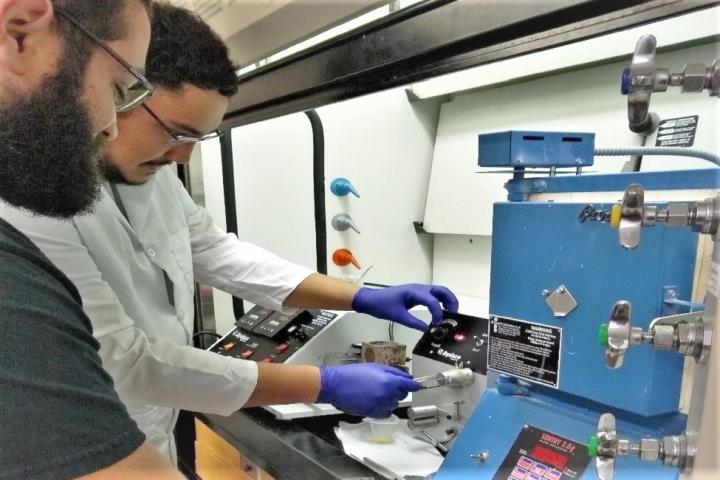FAU’s College of Engineering and Computer Science awarded $569,482 from combating terrorism technical support office

Credit: Florida Atlantic University
It sounds like something out of the movie “Iron Man,” where the fictional American superhero builds an armored suit to fight terrorists and overturn his captors. For researchers at Florida Atlantic University’s College of Engineering and Computer Science, developing and enhancing materials to improve the performance of military helmets and body armor is definitely not fictional.
They have received $569,482 from the Combating Terrorism Technical Support Office (CTTSO) under the advanced Armor Materials Program, to develop advanced fibers for body armor. Ballistic or bullet-proof armor performance is heavily dependent on the base material properties, which have changed little in recent years.
The CTTSO identifies and develops capabilities to combat terrorism at home and abroad and irregular adversaries and to deliver these capabilities to United States Department of Defense components and interagency partners through rapid research and development, advanced studies and technical innovation, and provision of support to U.S. military operations.
“Composite fiber plays a very important role in the performance of ballistic armor, and its mechanical properties are integrally related with kinetic energy absorption and dissipation,” said Stella Batalama, Ph.D., dean of FAU’s College of Engineering and Computer Science. “However, in recent years there have not been any significant advances in ballistic fiber properties, resulting in limited improvements of armor performance. With this important effort, our researchers will be able to enhance the properties of the fiber that will potentially lead to greater energy absorption and ballistic performance, and ultimately, greater protection of the women and men who serve in the United States military.”
The fibers in an armor absorb ballistic energy and dissipate it as quickly as possible when the projectile strikes. Fiber strength, modulus and fracture strain are key parameters for absorption and dissipation. FAU’s two-year project, “Hybridization of Ultrahigh Molecular Weight Polyethylene (UHMWPE) with Nylon and Carbon Nanotubes for Improved Ballistic Performance,” is aimed at improving the properties of UHMWPE fibers that are used in ballistic applications. The project involves two phases consisting of both experimental and computational approaches to investigate manufacturing, testing, and predicting the performance of the modified fiber. Testing of fibers will be performed at various rates of strain ranging from quasi-static to ballistic.
“Although current body armor provides increasingly advanced protection to our soldiers, it comes at a cost. It’s heavy, cumbersome, and way above the desired aerial density, which limits mobility and physical performance of our soldiers,” said Hassan Mahfuz, Ph.D., principal investigator, an expert in nanocomposite and structured materials and a professor in FAU’s Department of Ocean and Mechanical Engineering. “For more than a decade, considerable efforts have been made in carrying out various experimental, analytical and numerical investigations to identify and explain penetration-failure mechanisms under ballistic loading. We are hopeful the hybridized nanocomposite fiber we are developing will help to take body armor to the next level. We expect that it will possess excellent strength, modulus and fracture strain, which will lead to high energy absorption, and fast dissipation.”
The FAU project is led by Mahfuz, Oren Masory, Ph.D., a professor and an expert in robotics, rehabilitation engineering, and computerized manufacturing; and Leif A. Carlsson, Ph.D., the J.M. Rubin Foundation Professor and an expert in composite materials and solid mechanics, both in FAU’s Department of Ocean and Mechanical Engineering, in collaboration with the Naval Surface Warfare Center Panama City Division, and North Carolina State University.
###
About FAU’s College of Engineering and Computer Science:
Florida Atlantic University’s College of Engineering and Computer Science is committed to providing accessible and responsive programs of education and research recognized nationally for their high quality. Course offerings are presented on-campus, off-campus, and through distance learning in bioengineering, civil engineering, computer engineering, computer science, electrical engineering, environmental engineering, geomatics engineering, mechanical engineering and ocean engineering. For more information about the college, please visit eng.fau.edu.
About Florida Atlantic University:
Florida Atlantic University, established in 1961, officially opened its doors in 1964 as the fifth public university in Florida. Today, the University, with an annual economic impact of $6.3 billion, serves more than 30,000 undergraduate and graduate students at sites throughout its six-county service region in southeast Florida. FAU’s world-class teaching and research faculty serves students through 10 colleges: the Dorothy F. Schmidt College of Arts and Letters, the College of Business, the College for Design and Social Inquiry, the College of Education, the College of Engineering and Computer Science, the Graduate College, the Harriet L. Wilkes Honors College, the Charles E. Schmidt College of Medicine, the Christine E. Lynn College of Nursing and the Charles E. Schmidt College of Science. FAU is ranked as a High Research Activity institution by the Carnegie Foundation for the Advancement of Teaching. The University is placing special focus on the rapid development of critical areas that form the basis of its strategic plan: Healthy aging, biotech, coastal and marine issues, neuroscience, regenerative medicine, informatics, lifespan and the environment. These areas provide opportunities for faculty and students to build upon FAU’s existing strengths in research and scholarship. For more information, visit fau.edu.
Media Contact
Gisele Galoustian
[email protected]
561-297-2676




